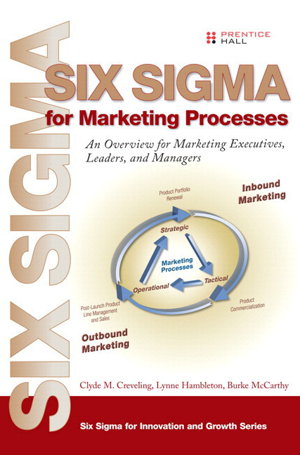| Fri | 9am – 5:30pm |
| Sat | 10am – 5pm |
| Sun | 12pm – 4pm |
| Mon | 9am – 5:30pm |
| Tue | 9am – 5:30pm |
| Wed | 9am – 5:30pm |
| Thu | 9am – 5:30pm |
Ask our staff anything about our shop or products, or share your feedback.

PublishedPrentice Hall Australia, August 2014 |
ISBN9780133992502 |
FormatSoftcover, 304 pages |
Dimensions23cm × 15.4cm × 1.6cm |
Nearly half of the top one hundred Fortune 500 companies use Six Sigma methodology in some part of their business. These companies have been among the top one hundred for five or more years and consistently report higher revenue and significantly higher profits than competitors.
This underscores the impact on the cost side. Now the focus moves to revenue growth. Six Sigma consultant Clyde M. Creveling's Design for Six Sigma in Technology and Product Development is the standard guide for product commercialization and manufacturing support engineers who want to apply Six Sigma methodology to technology development and product commercialization. Now, in Six Sigma for Marketing Processes, Creveling joins with Lynne Hambleton and Burke McCarthy to show the ways marketing professionals can adapt and apply those same Six Sigma concepts to create a lean marketing workflow built for growth.
This book provides an overview of the way marketing professionals can utilize the value offered by Six Sigma tools, methods, and best practices, within their existing phase-gate processes, as well as the traditional Six Sigma problem-solving approach: define, measure, analyze, improve, control (DMAIC). It provides unique methods for employing Six Sigma to enhance the three marketing processes for enabling a business to attain growth: strategic, tactical, and operational. It goes further to demonstrate the way Six Sigma for marketing and Six Sigma for design can be combined into a unified Six Sigma for growth. In this book, you'll learn how to apply Six Sigma methodology to
Develop a lean, efficient marketing workflow designed for growth
Enhance the three marketing arenas for growth: strategic, tactical, and operational
Identify leading indicators of growth and become proactive about performance improvement
Strengthen links between customers, products, and profitability
Redesign marketing work to streamline workflow and reduce variability
Assess and mitigate cycle-time risk in any marketing initiative or project
Leverage DMAIC to solve specific problems and improve existing processes
Use lean techniques to streamline repeatable processes, such as collateral development and trade-show participation
Preface xv
Acknowledgments xxiii
About the Authors xxv
Chapter 1: Introduction to Six Sigma for Marketing Processes 1
Chapter 2: Measuring Marketing Performance and Risk Accrual Using Scorecards 25
Chapter 3: Six Sigma-Enabled Project Management in Marketing Processes 45
Chapter 4: Six Sigma in the Strategic Marketing Process 63
Chapter 5: Six Sigma in the Tactical Marketing Process 117
Chapter 6: Six Sigma in the Operational Marketing Process 173
Chapter 7: Quick Review of Traditional DMAIC 209
Chapter 8: Future Trends in Six Sigma and Marketing Processes 229
Glossary 235
Index 261

